University Business Law Foundations Assignment: Contract Law Analysis
VerifiedAdded on 2020/04/21
|7
|1256
|338
Homework Assignment
AI Summary
This assignment delves into the foundations of business law, specifically focusing on contract law principles. It begins by defining the capacity of minors in contract law, referencing the Age of Majority Act 1971 and relevant case law such as Tan Hee Juan v Teh Boon Keat. The assignment then explores the concept of 'invitation to treat,' differentiating it from an offer and referencing the Malaysian Contract Act 1950 and cases like Eckhardt Marine GMBH v Sheriff. The third section discusses partnerships, outlining the legal requirements, including registration and partner responsibilities, under the Partnership Act 1961. Finally, the assignment examines the 'intention to create legal relations' as a crucial element for contract formation, citing cases such as Balfour vs. Balfour and Merritt vs. Merritt. The assignment provides a concise overview of these key aspects of contract law, making it a valuable resource for students studying business law.
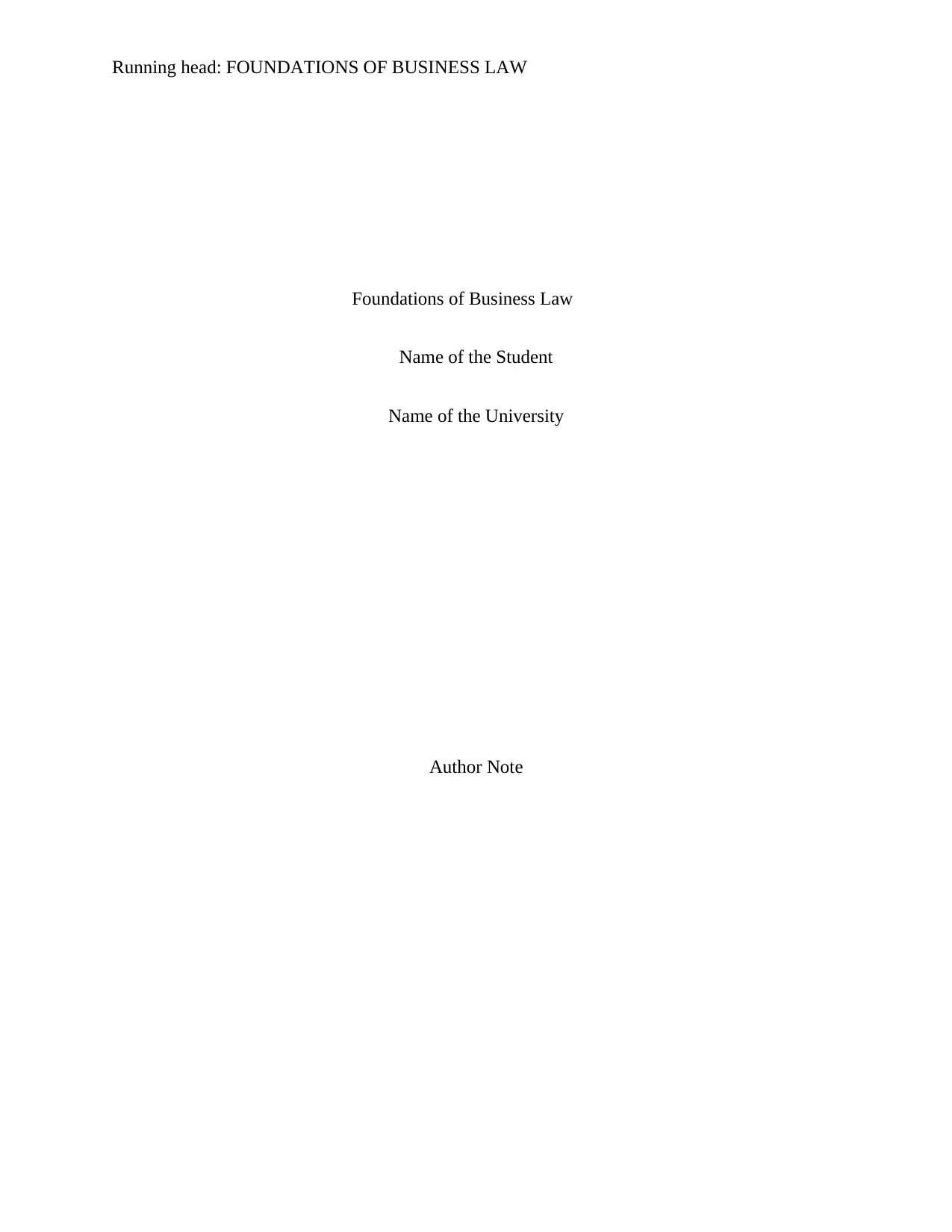
Running head: FOUNDATIONS OF BUSINESS LAW
Foundations of Business Law
Name of the Student
Name of the University
Author Note
Foundations of Business Law
Name of the Student
Name of the University
Author Note
Paraphrase This Document
Need a fresh take? Get an instant paraphrase of this document with our AI Paraphraser
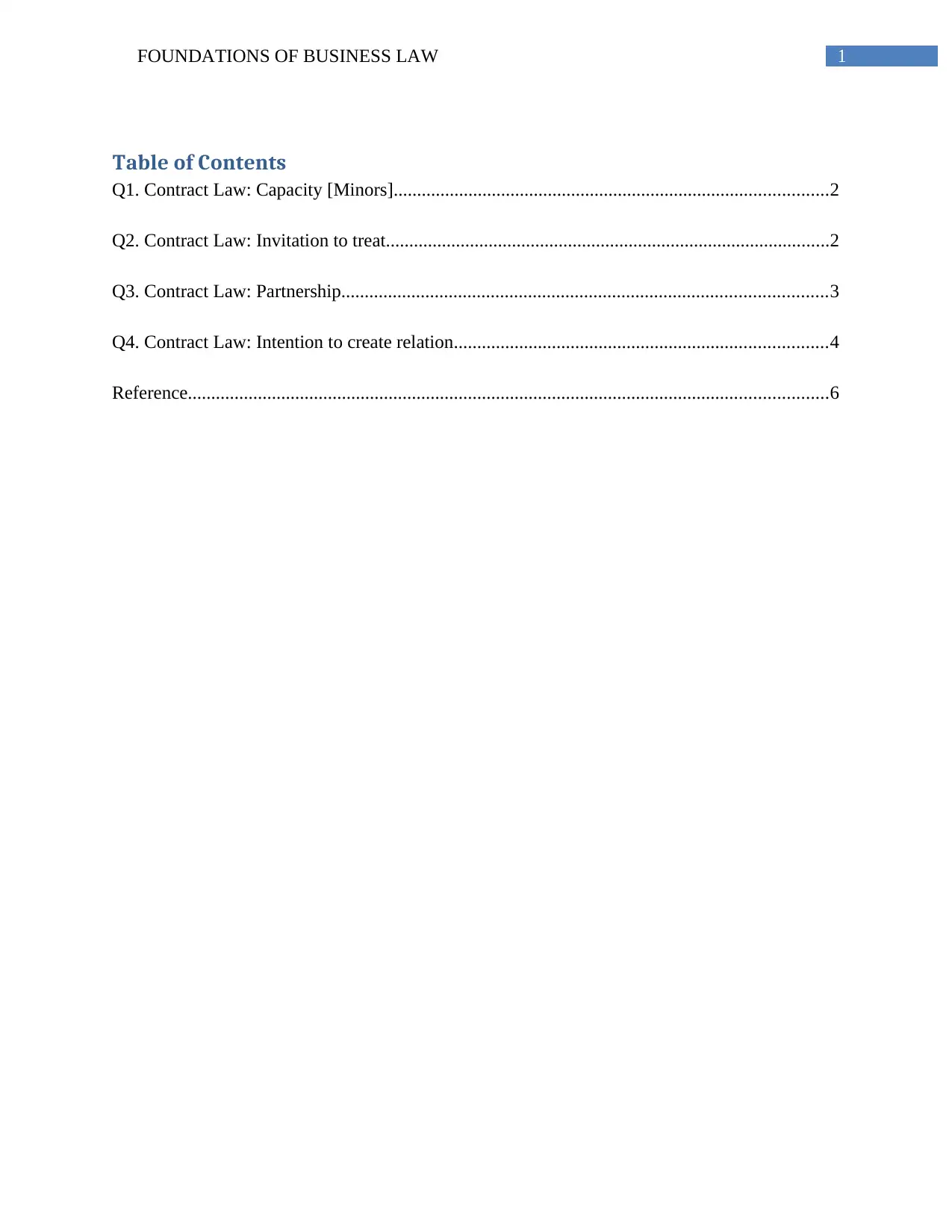
1FOUNDATIONS OF BUSINESS LAW
Table of Contents
Q1. Contract Law: Capacity [Minors].............................................................................................2
Q2. Contract Law: Invitation to treat...............................................................................................2
Q3. Contract Law: Partnership........................................................................................................3
Q4. Contract Law: Intention to create relation................................................................................4
Reference.........................................................................................................................................6
Table of Contents
Q1. Contract Law: Capacity [Minors].............................................................................................2
Q2. Contract Law: Invitation to treat...............................................................................................2
Q3. Contract Law: Partnership........................................................................................................3
Q4. Contract Law: Intention to create relation................................................................................4
Reference.........................................................................................................................................6
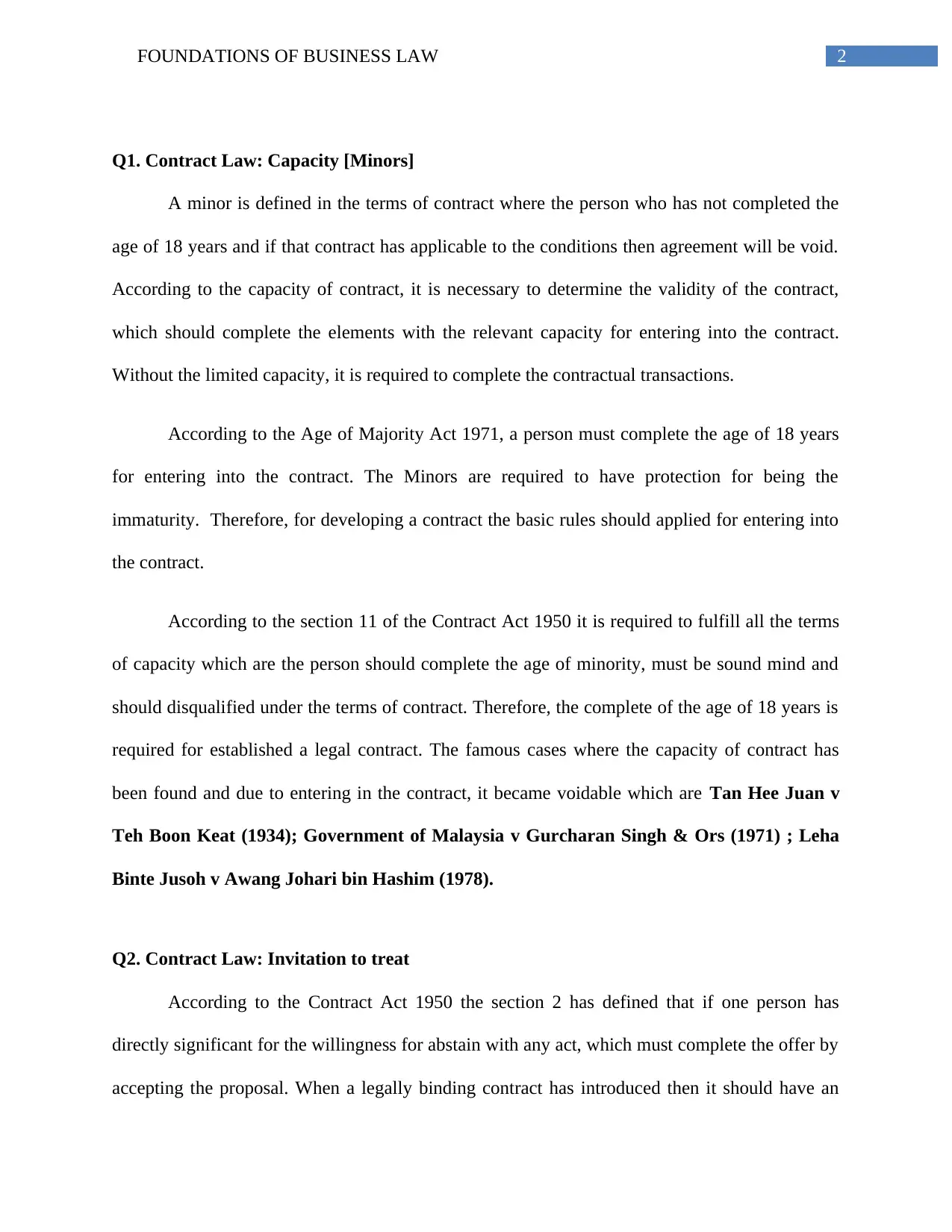
2FOUNDATIONS OF BUSINESS LAW
Q1. Contract Law: Capacity [Minors]
A minor is defined in the terms of contract where the person who has not completed the
age of 18 years and if that contract has applicable to the conditions then agreement will be void.
According to the capacity of contract, it is necessary to determine the validity of the contract,
which should complete the elements with the relevant capacity for entering into the contract.
Without the limited capacity, it is required to complete the contractual transactions.
According to the Age of Majority Act 1971, a person must complete the age of 18 years
for entering into the contract. The Minors are required to have protection for being the
immaturity. Therefore, for developing a contract the basic rules should applied for entering into
the contract.
According to the section 11 of the Contract Act 1950 it is required to fulfill all the terms
of capacity which are the person should complete the age of minority, must be sound mind and
should disqualified under the terms of contract. Therefore, the complete of the age of 18 years is
required for established a legal contract. The famous cases where the capacity of contract has
been found and due to entering in the contract, it became voidable which are Tan Hee Juan v
Teh Boon Keat (1934); Government of Malaysia v Gurcharan Singh & Ors (1971) ; Leha
Binte Jusoh v Awang Johari bin Hashim (1978).
Q2. Contract Law: Invitation to treat
According to the Contract Act 1950 the section 2 has defined that if one person has
directly significant for the willingness for abstain with any act, which must complete the offer by
accepting the proposal. When a legally binding contract has introduced then it should have an
Q1. Contract Law: Capacity [Minors]
A minor is defined in the terms of contract where the person who has not completed the
age of 18 years and if that contract has applicable to the conditions then agreement will be void.
According to the capacity of contract, it is necessary to determine the validity of the contract,
which should complete the elements with the relevant capacity for entering into the contract.
Without the limited capacity, it is required to complete the contractual transactions.
According to the Age of Majority Act 1971, a person must complete the age of 18 years
for entering into the contract. The Minors are required to have protection for being the
immaturity. Therefore, for developing a contract the basic rules should applied for entering into
the contract.
According to the section 11 of the Contract Act 1950 it is required to fulfill all the terms
of capacity which are the person should complete the age of minority, must be sound mind and
should disqualified under the terms of contract. Therefore, the complete of the age of 18 years is
required for established a legal contract. The famous cases where the capacity of contract has
been found and due to entering in the contract, it became voidable which are Tan Hee Juan v
Teh Boon Keat (1934); Government of Malaysia v Gurcharan Singh & Ors (1971) ; Leha
Binte Jusoh v Awang Johari bin Hashim (1978).
Q2. Contract Law: Invitation to treat
According to the Contract Act 1950 the section 2 has defined that if one person has
directly significant for the willingness for abstain with any act, which must complete the offer by
accepting the proposal. When a legally binding contract has introduced then it should have an
⊘ This is a preview!⊘
Do you want full access?
Subscribe today to unlock all pages.

Trusted by 1+ million students worldwide
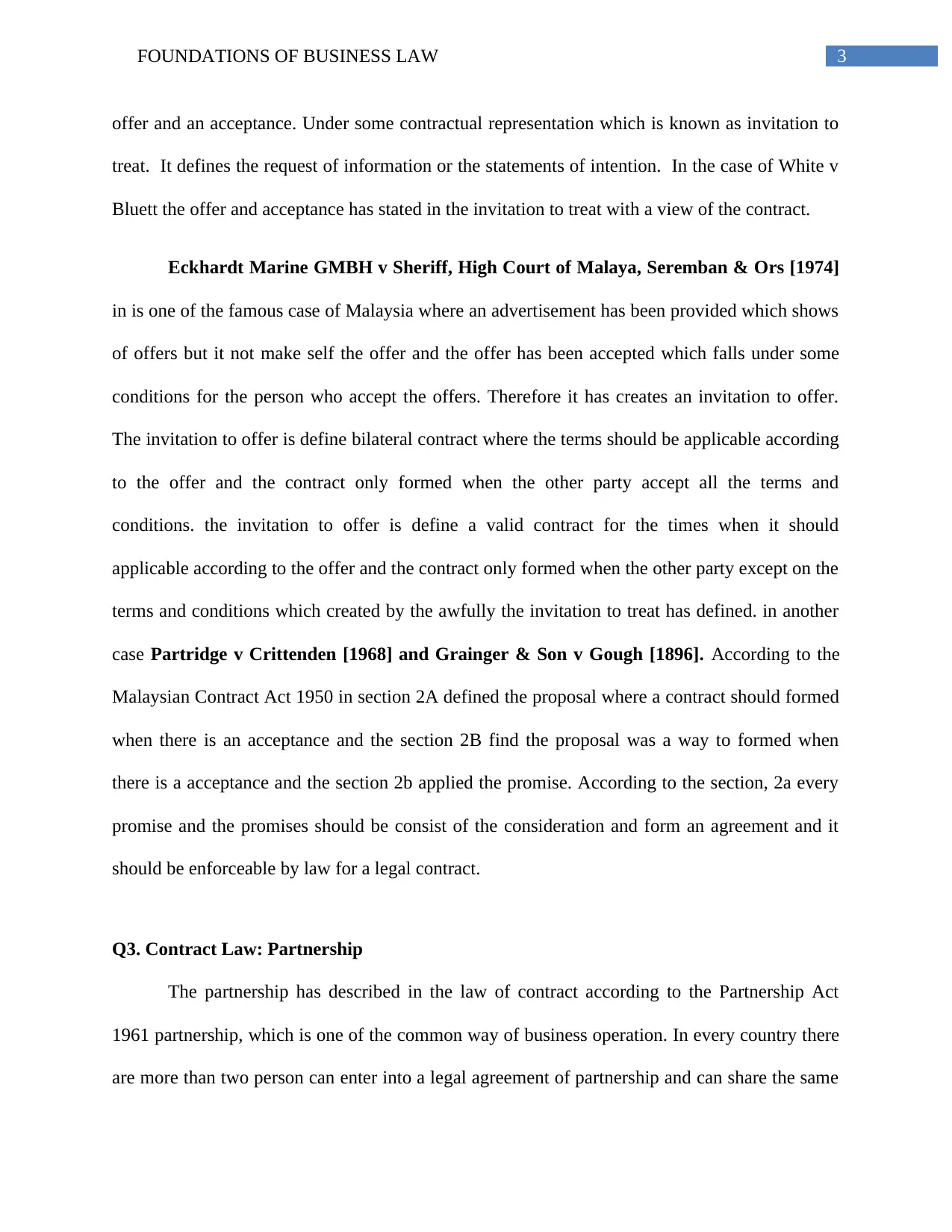
3FOUNDATIONS OF BUSINESS LAW
offer and an acceptance. Under some contractual representation which is known as invitation to
treat. It defines the request of information or the statements of intention. In the case of White v
Bluett the offer and acceptance has stated in the invitation to treat with a view of the contract.
Eckhardt Marine GMBH v Sheriff, High Court of Malaya, Seremban & Ors [1974]
in is one of the famous case of Malaysia where an advertisement has been provided which shows
of offers but it not make self the offer and the offer has been accepted which falls under some
conditions for the person who accept the offers. Therefore it has creates an invitation to offer.
The invitation to offer is define bilateral contract where the terms should be applicable according
to the offer and the contract only formed when the other party accept all the terms and
conditions. the invitation to offer is define a valid contract for the times when it should
applicable according to the offer and the contract only formed when the other party except on the
terms and conditions which created by the awfully the invitation to treat has defined. in another
case Partridge v Crittenden [1968] and Grainger & Son v Gough [1896]. According to the
Malaysian Contract Act 1950 in section 2A defined the proposal where a contract should formed
when there is an acceptance and the section 2B find the proposal was a way to formed when
there is a acceptance and the section 2b applied the promise. According to the section, 2a every
promise and the promises should be consist of the consideration and form an agreement and it
should be enforceable by law for a legal contract.
Q3. Contract Law: Partnership
The partnership has described in the law of contract according to the Partnership Act
1961 partnership, which is one of the common way of business operation. In every country there
are more than two person can enter into a legal agreement of partnership and can share the same
offer and an acceptance. Under some contractual representation which is known as invitation to
treat. It defines the request of information or the statements of intention. In the case of White v
Bluett the offer and acceptance has stated in the invitation to treat with a view of the contract.
Eckhardt Marine GMBH v Sheriff, High Court of Malaya, Seremban & Ors [1974]
in is one of the famous case of Malaysia where an advertisement has been provided which shows
of offers but it not make self the offer and the offer has been accepted which falls under some
conditions for the person who accept the offers. Therefore it has creates an invitation to offer.
The invitation to offer is define bilateral contract where the terms should be applicable according
to the offer and the contract only formed when the other party accept all the terms and
conditions. the invitation to offer is define a valid contract for the times when it should
applicable according to the offer and the contract only formed when the other party except on the
terms and conditions which created by the awfully the invitation to treat has defined. in another
case Partridge v Crittenden [1968] and Grainger & Son v Gough [1896]. According to the
Malaysian Contract Act 1950 in section 2A defined the proposal where a contract should formed
when there is an acceptance and the section 2B find the proposal was a way to formed when
there is a acceptance and the section 2b applied the promise. According to the section, 2a every
promise and the promises should be consist of the consideration and form an agreement and it
should be enforceable by law for a legal contract.
Q3. Contract Law: Partnership
The partnership has described in the law of contract according to the Partnership Act
1961 partnership, which is one of the common way of business operation. In every country there
are more than two person can enter into a legal agreement of partnership and can share the same
Paraphrase This Document
Need a fresh take? Get an instant paraphrase of this document with our AI Paraphraser
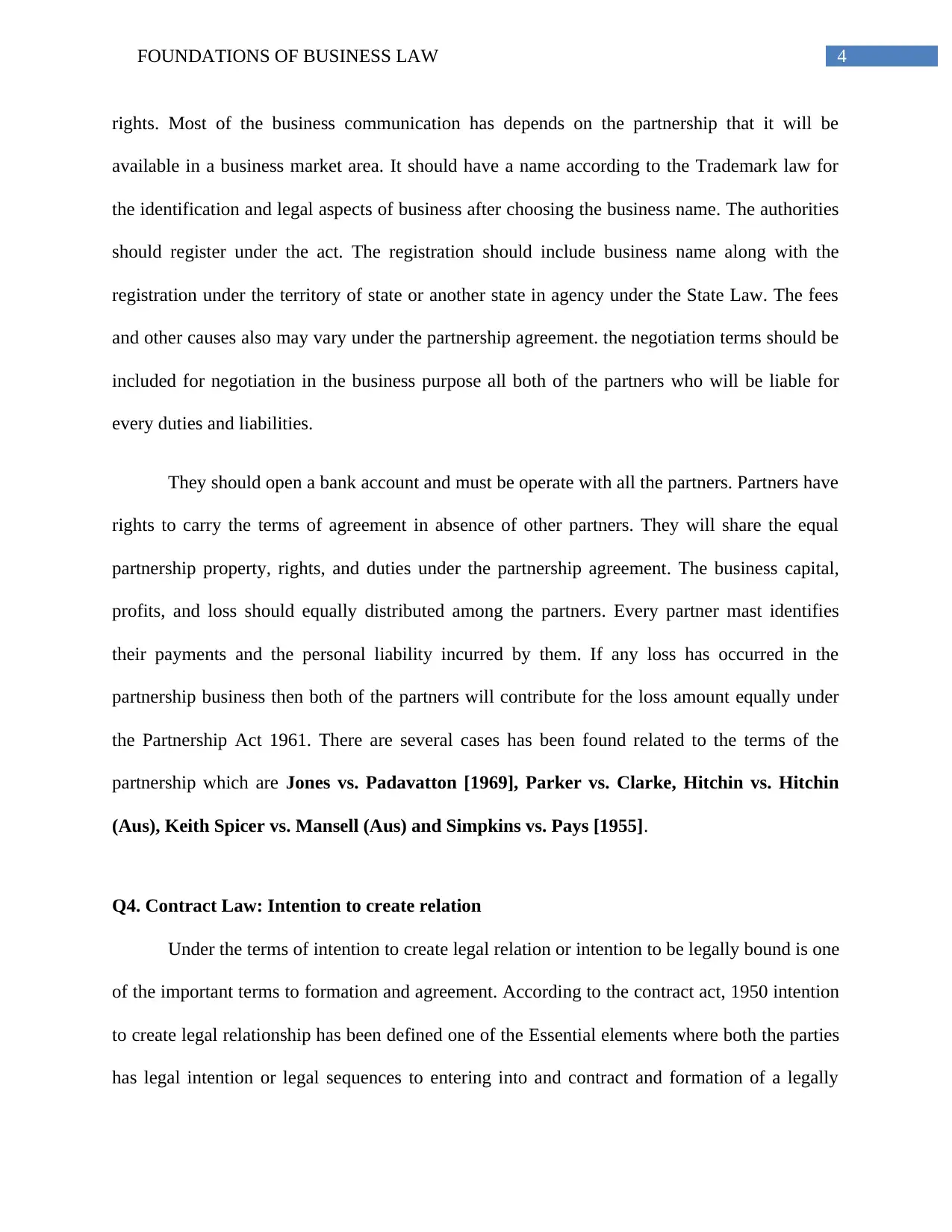
4FOUNDATIONS OF BUSINESS LAW
rights. Most of the business communication has depends on the partnership that it will be
available in a business market area. It should have a name according to the Trademark law for
the identification and legal aspects of business after choosing the business name. The authorities
should register under the act. The registration should include business name along with the
registration under the territory of state or another state in agency under the State Law. The fees
and other causes also may vary under the partnership agreement. the negotiation terms should be
included for negotiation in the business purpose all both of the partners who will be liable for
every duties and liabilities.
They should open a bank account and must be operate with all the partners. Partners have
rights to carry the terms of agreement in absence of other partners. They will share the equal
partnership property, rights, and duties under the partnership agreement. The business capital,
profits, and loss should equally distributed among the partners. Every partner mast identifies
their payments and the personal liability incurred by them. If any loss has occurred in the
partnership business then both of the partners will contribute for the loss amount equally under
the Partnership Act 1961. There are several cases has been found related to the terms of the
partnership which are Jones vs. Padavatton [1969], Parker vs. Clarke, Hitchin vs. Hitchin
(Aus), Keith Spicer vs. Mansell (Aus) and Simpkins vs. Pays [1955].
Q4. Contract Law: Intention to create relation
Under the terms of intention to create legal relation or intention to be legally bound is one
of the important terms to formation and agreement. According to the contract act, 1950 intention
to create legal relationship has been defined one of the Essential elements where both the parties
has legal intention or legal sequences to entering into and contract and formation of a legally
rights. Most of the business communication has depends on the partnership that it will be
available in a business market area. It should have a name according to the Trademark law for
the identification and legal aspects of business after choosing the business name. The authorities
should register under the act. The registration should include business name along with the
registration under the territory of state or another state in agency under the State Law. The fees
and other causes also may vary under the partnership agreement. the negotiation terms should be
included for negotiation in the business purpose all both of the partners who will be liable for
every duties and liabilities.
They should open a bank account and must be operate with all the partners. Partners have
rights to carry the terms of agreement in absence of other partners. They will share the equal
partnership property, rights, and duties under the partnership agreement. The business capital,
profits, and loss should equally distributed among the partners. Every partner mast identifies
their payments and the personal liability incurred by them. If any loss has occurred in the
partnership business then both of the partners will contribute for the loss amount equally under
the Partnership Act 1961. There are several cases has been found related to the terms of the
partnership which are Jones vs. Padavatton [1969], Parker vs. Clarke, Hitchin vs. Hitchin
(Aus), Keith Spicer vs. Mansell (Aus) and Simpkins vs. Pays [1955].
Q4. Contract Law: Intention to create relation
Under the terms of intention to create legal relation or intention to be legally bound is one
of the important terms to formation and agreement. According to the contract act, 1950 intention
to create legal relationship has been defined one of the Essential elements where both the parties
has legal intention or legal sequences to entering into and contract and formation of a legally

5FOUNDATIONS OF BUSINESS LAW
binding agreement. When contract has been formed it should Binding in a legal contract to make
the contract completely. The cases are where it is applicable the intension to create legal relations
are Balfour vs. Balfour [1919] and Merritt vs. Merritt [1970].
binding agreement. When contract has been formed it should Binding in a legal contract to make
the contract completely. The cases are where it is applicable the intension to create legal relations
are Balfour vs. Balfour [1919] and Merritt vs. Merritt [1970].
⊘ This is a preview!⊘
Do you want full access?
Subscribe today to unlock all pages.

Trusted by 1+ million students worldwide
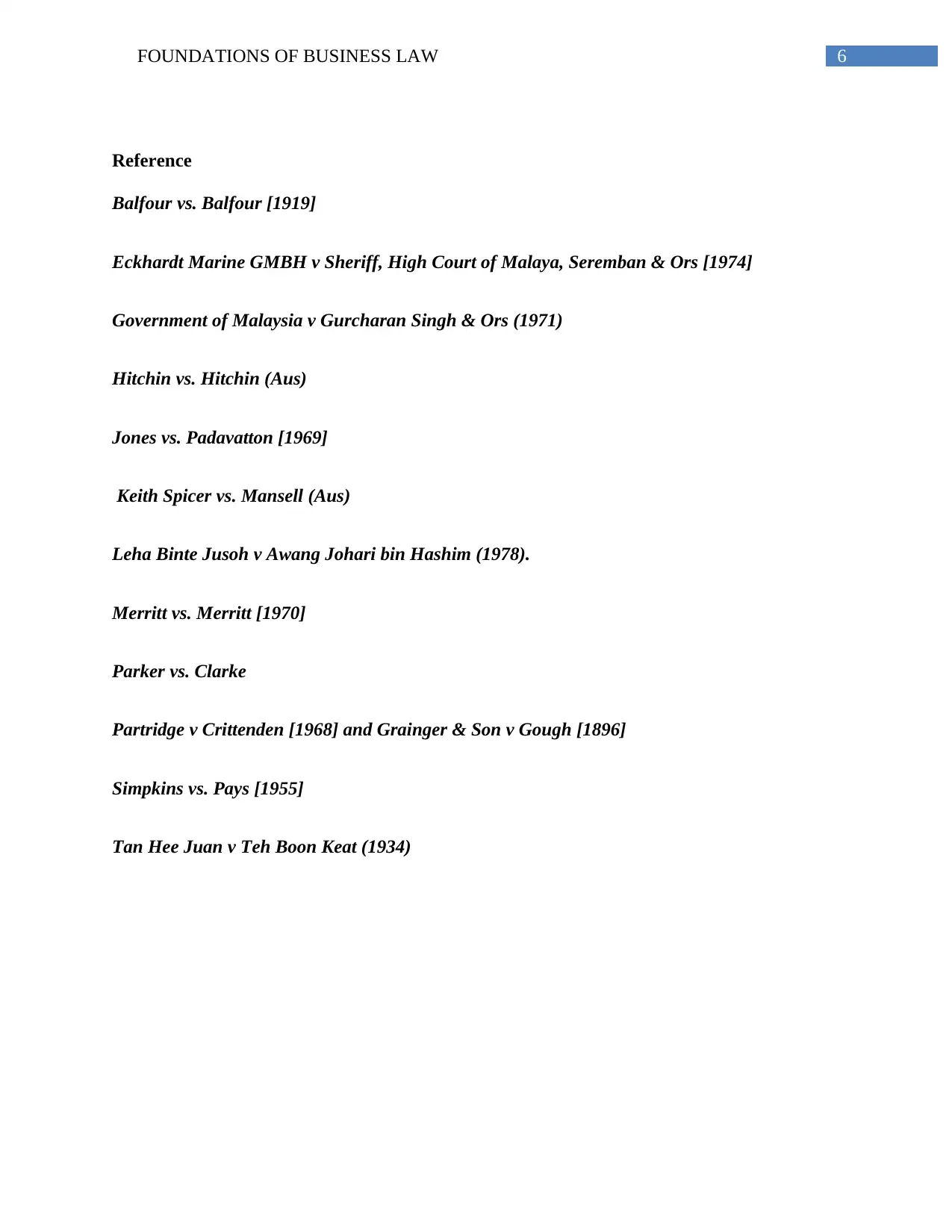
6FOUNDATIONS OF BUSINESS LAW
Reference
Balfour vs. Balfour [1919]
Eckhardt Marine GMBH v Sheriff, High Court of Malaya, Seremban & Ors [1974]
Government of Malaysia v Gurcharan Singh & Ors (1971)
Hitchin vs. Hitchin (Aus)
Jones vs. Padavatton [1969]
Keith Spicer vs. Mansell (Aus)
Leha Binte Jusoh v Awang Johari bin Hashim (1978).
Merritt vs. Merritt [1970]
Parker vs. Clarke
Partridge v Crittenden [1968] and Grainger & Son v Gough [1896]
Simpkins vs. Pays [1955]
Tan Hee Juan v Teh Boon Keat (1934)
Reference
Balfour vs. Balfour [1919]
Eckhardt Marine GMBH v Sheriff, High Court of Malaya, Seremban & Ors [1974]
Government of Malaysia v Gurcharan Singh & Ors (1971)
Hitchin vs. Hitchin (Aus)
Jones vs. Padavatton [1969]
Keith Spicer vs. Mansell (Aus)
Leha Binte Jusoh v Awang Johari bin Hashim (1978).
Merritt vs. Merritt [1970]
Parker vs. Clarke
Partridge v Crittenden [1968] and Grainger & Son v Gough [1896]
Simpkins vs. Pays [1955]
Tan Hee Juan v Teh Boon Keat (1934)
1 out of 7
Related Documents
Your All-in-One AI-Powered Toolkit for Academic Success.
+13062052269
info@desklib.com
Available 24*7 on WhatsApp / Email
![[object Object]](/_next/static/media/star-bottom.7253800d.svg)
Unlock your academic potential
Copyright © 2020–2025 A2Z Services. All Rights Reserved. Developed and managed by ZUCOL.





